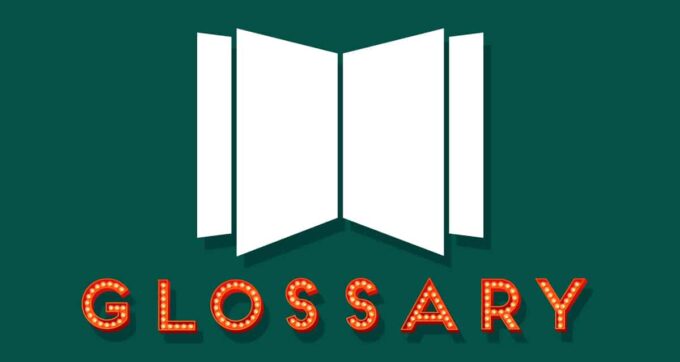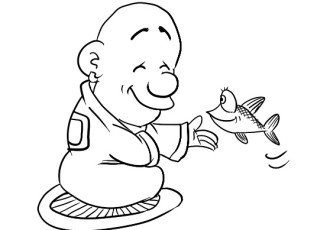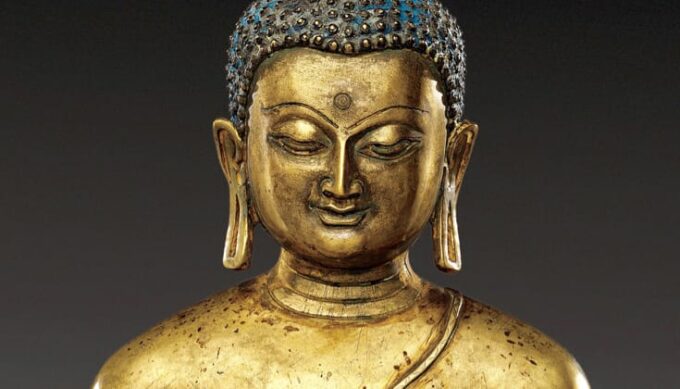A B C D E F G H I J K L M N O P Q R S T U V X Y Z
_______________________
A
Āchārya – Sanskrit for ‘teacher’; in Zen monasteries, a polite form of address for a monk with at least five years of training; applied to a disciple advanced enough to teach monks and laity, but not yet deemed a Master.
Arhat – In Zen, one whose heart is cleansed of all greed, hatred, and delusion but who has not yet fully realized wise discernment or compassion.
Asura – An inhabitant of one of the six Worlds of Existence; before conversion, a heaven stormer, one who is so absorbed in attaining power that he cannot hear the Dharma, much less comprehend It; after conversion, he becomes a guardian of Buddhism.
Avalokiteshvara (C. Kuan Yin, J. Kanzeon or Kannon) – The Bodhisattva who hearkens to the cries of the world; the embodiment of compassion.
_______________________
B
Bodhisattva – When not capitalized, it refers to one who is attempting to follow the Mahāyāna (Greater Course) as the Buddha Path; when capitalized, the personification of some aspect of Buddha Nature.
A broken wooden ladle – A Zen metaphor describing someone’s mind which has become free of discriminatory thinking.
_______________________
D
A dragon elephant – Originally, a term for a particularly large elephant; used in Zen texts to describe a particularly brilliant and discerning Master.
_______________________
F
The four stages of arhathood – (1) Stream-enterer – someone who enters into the stream of Buddhist training by abandoning false views; (2) Once-returner – someone having one more rebirth before realizing full enlightenment; (3) Non-returner – someone never returning to the realm of sensual desire; and (4) Arhat – someone who has reached a state of enlightenment and is therefore free from all defiling passions.
_______________________
G
Gasshō – A gesture made by placing the palms of the hands together, with fingers pointing upwards, signifying the unity of body and mind. It is an expression of reverence often used during ceremonies, as well as a form of greeting when two Buddhists meet and a gesture of supplication.
Greater Course (Greater Vehicle) – A translation of the term ‘Mahāyāna’, used to designate the Buddhist traditions that place the awakening of all sentient beings above one’s personal awakening.
_______________________
H
Hossu – A scepter-like instrument in the form of a fly-whisk carried by a celebrant during ceremonies. It represents the flowing forth of the Water of the Spirit as an expression of the celebrant’s compassion.
_______________________
I
Icchantika – Someone who is erroneously thought to be so amoral as to be completely devoid of Buddha Nature. In Zen, there is reference to the Great Icchantika, which is an epithet for Buddha Nature itself.
_______________________
J
Jambudvipa – In Buddhist spiritual cosmology, the Southern Continent where people are capable of doing Buddhist training.
_______________________
K
Kalpa – An endlessly long period of time, roughly equivalent to an eon.
Karma – What results from any volitional action, according to the universal law of cause and effect.
Kenshō – The experience of seeing into one’s true nature, that is, one’s Buddha Nature.
Kesa – A cloak-like robe traditionally worn by Buddhist monastics since the time of Shakyamuni Buddha. A similar type of robe is given to committed lay Buddhists.
Kinhin – is the walking meditation that is practiced between long periods of the sitting meditation / Zazen.
Kōan – A statement or story used by a Zen Master as a teaching device to directly address a trainee’s spiritual question; also may be used to refer to that question itself.
_______________________
L
Lantern (stone or temple) – A term often used metaphorically for a monk who stays in a monastery or temple, serving as a light to help guide a trainee.
Lion Throne (Lion’s Seat) – The seat where a Master sits when giving a talk on some aspect of the Dharma.
Lord of Emptiness – The first of the Seven Buddhas, the one who lived during the Age of Emptiness, that is, before duality had first arisen.
_______________________
M
Mahāsattva – An outstanding bodhisattva.
Mahāyāna – The Greater Vehicle.
Maitreya – The Buddha Yet to Come. He is said to be waiting as a Bodhisattva in the Tushita Heaven. To realize one’s own Buddha Nature brings Maitreya forth.
Manjushri – The Bodhisattva who personifies Great Wisdom.
Matter (the One Great Matter) – The goal of spiritual training, namely, the realization of the highest Truth.
Monjin – The act of bowing from the waist with hands in gasshō.
_______________________
P
A pillar of the temple – A monk whose training is so strong that it supports the spiritual function of the temple or monastery in which he trains.
Pratyekabuddha – One who becomes enlightened as a result of his own efforts but does not share his understanding with others.
_______________________
S
Samantabhadra – The Bodhisattva who is the embodiment of patient, loving activity.
Seal (Buddha seal, Buddha Mind seal, Dharma seal, and seal of certification) – ‘The Buddha Mind Seal’ refers not only to the document written on plum blossom silk which certifies both the Master’s and the disciple’s Buddha Mind but also to the fact that the Minds of Master and disciple coincide and are not two separate minds. The Transmission of this seal is often referred to in Zen texts as ‘the Transmission of Mind to Mind’ as well as ‘the special Transmission that is apart from Scriptural texts and which does not depend on words’.
The Seven Buddhas – The historical Buddha and the six Buddhas that preceded Him.
The seven treasures (the seven jewels) – The seven types of jewels from which Pure Lands are fashioned.
Shashu – The way that the hands are held when doing walking meditation, kinhin. There are various forms of shashu, but most involve one hand being wrapped around the fist of the other.
Shravaka – One who, upon hearing the Dharma, affirms his allegiance to It but may not yet try to put It into practice, or may try to reduce It simply to a rigid code of ‘right’ or ‘wrong’ behaviors.
The six Worlds of Existence – Those of celestial beings, humans, asuras, hungry ghosts, beasts, and those in hellish states.
Skandhas – The five skandhas comprising a living being’s physical form, sensory perceptions, mental concepts and ideas, volition, and consciousness.
Stupa – Literally, a reliquary for the ashes of a Buddhist, and metaphorically, the body of a Buddha.
_______________________
T
The Three Courses (the Three Vehicles) – Namely, the way of training done by the shravakas, pratyekabuddhas, and bodhisattvas.
Tripitaka – The three divisions of Buddhist Scriptures, namely, the Buddha’s Teachings (Sutras), the Precepts (Vinaya), and the commentaries on the Sutras (Abhi- dharmas); also, the whole of the Buddhist canon.
_______________________
V
Vairochana (the Cosmic Buddha) – The Buddha who is the personification of spiritual Light and Truth, the one who represents the Pure Buddha Mind.
Vimalakīrti – A wealthy lay Buddhist renowned for his profound understanding of Mahāyāna.
_______________________
Y
Yojana – An Indian measure of distance, understood by some scholars as equivalent to twelve or sixteen miles (twenty or twenty-five km).
_______________________
_______________________
Sources
Shōbōgenzō – Eihei Dōgen (translated by Hubert Nearman – First edition, 2007)




